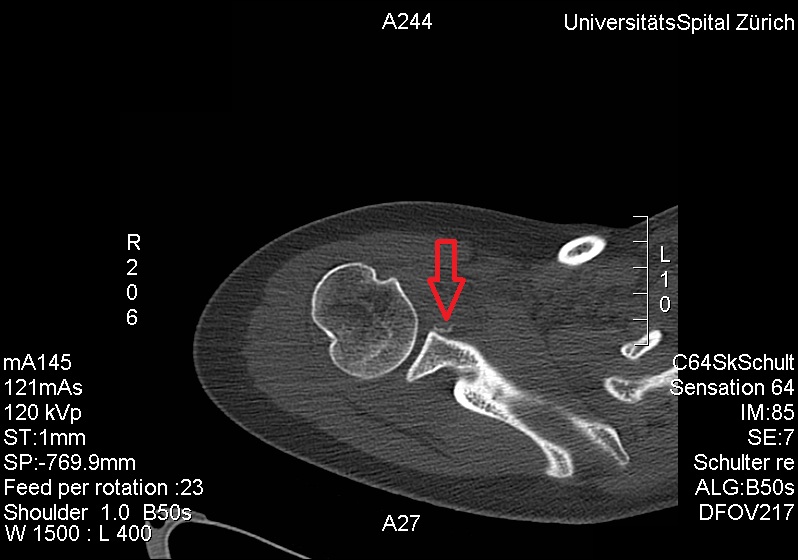In order to understand this condition, it is important to understand the anatomy and function of the shoulder. Please read Shoulder Pain Info’s section on basic shoulder anatomy. For additional background information on the biomechanics of the shoulder please read Shoulder Pain Info’s section on basic shoulder biomechanics.

What is the anatomy of the glenoid labrum?
The shoulder complex is made up of three bones, which are connected by muscles, ligaments, and tendons. The large bone in the upper arm is called the humerus. The shoulder blade is called the scapula and collarbone is called the clavicle.
The top of the humerus is shaped like a ball. This ball sits in a socket on the end of the scapula. The ball is called the head of the humerus and the socket is called the glenoid fossa, hence the term “glenohumeral” joint. The glenoid fossa has a rim of tissue around it called the glenoid labrum. The glenoid labrum makes the glenoid fossa deeper and improves the stability of the glenohumeral joint, which is the most mobile joint in the body.
Tendons connect muscles to bone. There are four muscles (supraspinatus, infraspinatus, subscapularis and teres minor) that surround the glenohumeral joint. These four muscles are attached to the scapula. They turn into tendons, which in turn attach to the humerus. The tendons of these four muscles make up the “rotator cuff” that blends into and helps support the glenohumeral joint capsule. The muscles of the rotator cuff and their tendons also provide stability to the glenohumeral joint.
What is a labral tear and what causes them?
When the glenoid labrum becomes injured or torn, it is described as a labral tear. These tears may be classified by the position of the tear in relation to the glenoid which is often called the “shoulder socket”.

RSatUSZ, CC BY-SA 3.0 https://creativecommons.org/licenses/by-sa/3.0, via Wikimedia Commons
Bankhart Tear:
A Bankhart tear is a tear in the labrum located in the front, lower (anterior, inferior) part of the shoulder socket. This type of tear occurs most commonly during a shoulder dislocation. A Bankhart tear makes the shoulder more prone to recurrent dislocations.
SLAP Tear:
A SLAP tear is a tear in the labrum that covers the top part of the shoulder socket from front to back (Superior Labral tear from Anterior to Posterior). A SLAP tear occurs at the point where the long head of biceps tendon attaches. This type of tear occurs most commonly during falls on an outstretched arm.
A labral tear may also develop gradually for a variety of reasons. Some of the risk factors include:
– Repetitive movements that create excessive motion at the glenohumeral joint such as throwing.
– Activities that require the biceps muscles to contract sharply against the labrum such as heavy weightlifting, pitching or golfing.
What does a labral tear feel like?
The symptoms of a labral tear may include a clicking or catching sensation in the shoulder during certain movements and/or a vague pain in the front or top of the shoulder. In some cases a labral tear may not cause any pain.
Can a labral tear be detected on X-rays?
X-rays can rule out chips, cracks or other problems with bones but they can not identify soft tissue injuries like labral tears. MRI arthrograms are very effective in identifying labral tears. The “gold” standard for identifying a labral tear is arthroscopic surgery of the shoulder.
A physician or physical therapist may use one of the following special tests to diagnose a labral tear:
What is the treatment for a labral tear?
A lot can be done to help people who have a labral tear. Most times, treatment will begin with a conservative approach. A program of stretching and strengthening exercises, icing, pain medications or anti-inflammatory medications may be used to help decrease pain and improve function of the shoulder. Doctors and physical therapists who deal with people who have labral tears can help outline an individualized treatment program.
If the conservative approach to managing a labral tear is not effective, surgery may be required. An orthopaedic surgeon may be able to repair or remove the torn part of the labrum through arthroscopic surgery or through an open shoulder procedure. If the labral tear is also associated with an unstable glenohumeral joint, the surgeon may also be able to surgically stabilize the glenohumeral joint.
What other information is available on labral tears?
Shoulder Pain Info’s links section has additional information on this topic. Links have been provided to other websites as well as online medical journals.
